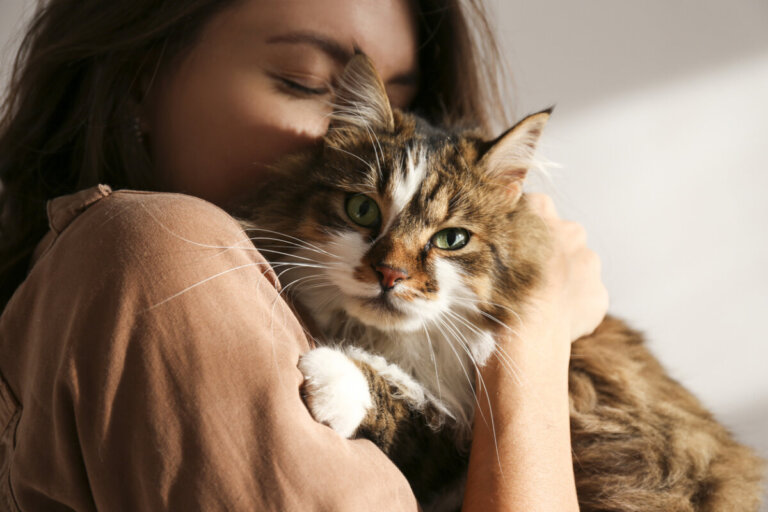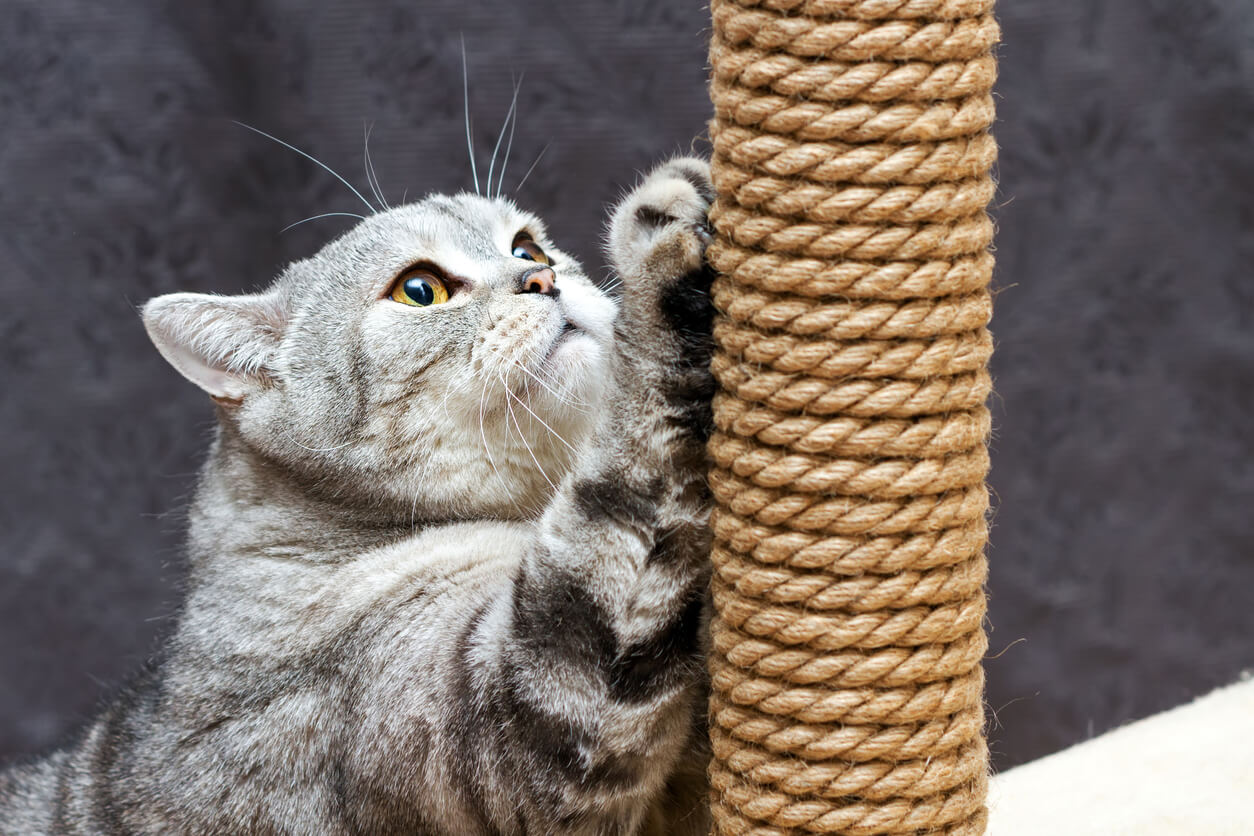5 Strategies to Promote Your Cat's Well-Being

Pets are adorable and fascinating creatures that bring companionship and joy into our lives. As the person responsible for their care, it’s essential to ensure that they enjoy good health and optimal development. Taking into account certain factors necessary for their care will undoubtedly make a big difference in their lives. Find out how to promote your cat’s well-being in this article!
From providing them with an adequate diet, to taking out veterinary insurance for cats, it’s crucial that owners are aware of all their pets’ needs and, in addition to their love and companionship, look after their health and happiness at all times. In this article, we bring you some recommendations that will be of great help to promote your cat’s well-being and strengthen the bond between the two of you.
Promote your cat’s well-being with these tips
Providing a good quality of life for your pets isn’t only about meeting their basic needs, such as food and shelter, but also about providing them with a day-to-day life full of enriching and stimulating adventures. Applying the following prevention and care strategies can benefit your cat’s life and allow for a harmonious and happy coexistence at home.
1. Provide a complete vaccination schedule

Vaccinations are the most effective tools to avoid infectious and parasitic diseases that can endanger your cat’s life. They should be administered by a certified veterinarian every few years until the protection schedule is complete. Considering investing in pet insurance is a great option to have all veterinary expenses covered.
Among the essential vaccines for cats are those that protect against feline panleukopenia virus (FPV), herpesvirus (FHV-1) and calicivirus (FCV). These diseases represent a significant risk to feline health and therefore it is recommended that all kittens be protected against them.
2. Provide a balanced diet
If you care about your cat’s health and well-being, it’s essential that you provide an excellent quality diet that meets all of your cat’s nutritional requirements. Read product labels and choose those that contain high-quality ingredients, such as lean meats and animal-based proteins.
According to a study published in the journal Frontiers in Microbiology, a cat’s diet plays a major role in their gut microbiome and overall health. Therefore, owners have a great responsibility to be the ones who provide food for their pets. We recommend that you buy concentrates that include probiotics and prebiotics.
Keep in mind that cats are carnivores by nature, which means they have particular dietary needs. Make sure your cat’s diet includes sufficient animal protein, essential fatty acids, vitamins, and minerals. To prevent them from becoming overweight and to improve digestion, divide several small meals throughout the day.
3. Encourage exercise and physical activity

Cats are naturally playful animals and you need to help them release their energy throughout the day. Provide interactive toys that stimulate your furry one’s hunting instinct, such as feathered objects, balls, or mice.
Also, create an enriching environment for your cat with climbing structures, scratching posts, and play areas. This will provide opportunities for jumping, climbing, and exploring, which will contribute to their daily exercise and help keep them active and moving.
Don’t forget to spend quality time and give them one-on-one attention through petting and massage, which promotes exercise and strengthens the bond between the two of you.
4. Provide a safe and comfortable environment
Give your cat a soft bed or pillow in a quiet area of the house where they can relax and sleep undisturbed, and design areas of refuge and hiding places, such as high shelves, boxes, or covered beds. This will provide a safe place for them to go when they feel stressed or need a moment of solitude.
On the other hand, keep your kitty’s food and water area clean and their litter box clear at all times. A clean and odor-free environment contributes to your cat’s well-being and the comfort of everyone in the household.
Remember that cats are domestic animals, and although their adventurous instinct makes them want to leave the safety of the house, it’s essential that owners do their best to prevent this from happening. The street is full of dangers that put their lives at risk.
5. Stimulate the mind and curiosity
Cats are very intelligent animals and offering them a variety of stimuli in their environment can keep their minds active. Introduce toys that emit interesting sounds, movements, or textures. Also, place scratching posts, climbing trees, and high shelves so your cat can explore different heights and textures.
To contribute to their sensory stimulation, you can also make regular changes to the environment to keep them interested. This includes changing the arrangement of furniture, adding new items such as boxes or tunnels, or even teaching them different smells and sounds to pique their curiosity.
Protect your cat’s well-being and health
Giving cats a good quality of life requires a holistic approach that encompasses different aspects. And the strategies presented in this article can have a positive impact on a cat’s health and strengthen the bond with their owner. Put them into practice!
Pets are adorable and fascinating creatures that bring companionship and joy into our lives. As the person responsible for their care, it’s essential to ensure that they enjoy good health and optimal development. Taking into account certain factors necessary for their care will undoubtedly make a big difference in their lives. Find out how to promote your cat’s well-being in this article!
From providing them with an adequate diet, to taking out veterinary insurance for cats, it’s crucial that owners are aware of all their pets’ needs and, in addition to their love and companionship, look after their health and happiness at all times. In this article, we bring you some recommendations that will be of great help to promote your cat’s well-being and strengthen the bond between the two of you.
Promote your cat’s well-being with these tips
Providing a good quality of life for your pets isn’t only about meeting their basic needs, such as food and shelter, but also about providing them with a day-to-day life full of enriching and stimulating adventures. Applying the following prevention and care strategies can benefit your cat’s life and allow for a harmonious and happy coexistence at home.
1. Provide a complete vaccination schedule

Vaccinations are the most effective tools to avoid infectious and parasitic diseases that can endanger your cat’s life. They should be administered by a certified veterinarian every few years until the protection schedule is complete. Considering investing in pet insurance is a great option to have all veterinary expenses covered.
Among the essential vaccines for cats are those that protect against feline panleukopenia virus (FPV), herpesvirus (FHV-1) and calicivirus (FCV). These diseases represent a significant risk to feline health and therefore it is recommended that all kittens be protected against them.
2. Provide a balanced diet
If you care about your cat’s health and well-being, it’s essential that you provide an excellent quality diet that meets all of your cat’s nutritional requirements. Read product labels and choose those that contain high-quality ingredients, such as lean meats and animal-based proteins.
According to a study published in the journal Frontiers in Microbiology, a cat’s diet plays a major role in their gut microbiome and overall health. Therefore, owners have a great responsibility to be the ones who provide food for their pets. We recommend that you buy concentrates that include probiotics and prebiotics.
Keep in mind that cats are carnivores by nature, which means they have particular dietary needs. Make sure your cat’s diet includes sufficient animal protein, essential fatty acids, vitamins, and minerals. To prevent them from becoming overweight and to improve digestion, divide several small meals throughout the day.
3. Encourage exercise and physical activity

Cats are naturally playful animals and you need to help them release their energy throughout the day. Provide interactive toys that stimulate your furry one’s hunting instinct, such as feathered objects, balls, or mice.
Also, create an enriching environment for your cat with climbing structures, scratching posts, and play areas. This will provide opportunities for jumping, climbing, and exploring, which will contribute to their daily exercise and help keep them active and moving.
Don’t forget to spend quality time and give them one-on-one attention through petting and massage, which promotes exercise and strengthens the bond between the two of you.
4. Provide a safe and comfortable environment
Give your cat a soft bed or pillow in a quiet area of the house where they can relax and sleep undisturbed, and design areas of refuge and hiding places, such as high shelves, boxes, or covered beds. This will provide a safe place for them to go when they feel stressed or need a moment of solitude.
On the other hand, keep your kitty’s food and water area clean and their litter box clear at all times. A clean and odor-free environment contributes to your cat’s well-being and the comfort of everyone in the household.
Remember that cats are domestic animals, and although their adventurous instinct makes them want to leave the safety of the house, it’s essential that owners do their best to prevent this from happening. The street is full of dangers that put their lives at risk.
5. Stimulate the mind and curiosity
Cats are very intelligent animals and offering them a variety of stimuli in their environment can keep their minds active. Introduce toys that emit interesting sounds, movements, or textures. Also, place scratching posts, climbing trees, and high shelves so your cat can explore different heights and textures.
To contribute to their sensory stimulation, you can also make regular changes to the environment to keep them interested. This includes changing the arrangement of furniture, adding new items such as boxes or tunnels, or even teaching them different smells and sounds to pique their curiosity.
Protect your cat’s well-being and health
Giving cats a good quality of life requires a holistic approach that encompasses different aspects. And the strategies presented in this article can have a positive impact on a cat’s health and strengthen the bond with their owner. Put them into practice!
All cited sources were thoroughly reviewed by our team to ensure their quality, reliability, currency, and validity. The bibliography of this article was considered reliable and of academic or scientific accuracy.
- Davies, R. H., Lawes, J. R., & Wales, A. D. (2019). Raw diets for dogs and cats: a review, with particular reference to microbiological hazards. Journal of Small Animal Practice, 60(6), 329-339. Recuperado de: https://onlinelibrary.wiley.com/doi/full/10.1111/jsap.13000
- Milán, J. P., Suárez, M., Reisinho, A., Corrales, G. M., Rodríguez, M. D. T., Ramírez, J. G., & de Morais, H. A. (2020). Recomendaciones de inmunización para las enfermedades infecciosas de perros y gatos en España y Portugal. Clínica veterinaria de pequeños animales: revista oficial de AVEPA, Asociación Veterinaria Española de Especialistas en Pequeños Animales, 40(1), 1-6. Recuperado de: https://www.clinvetpeqanim.com/index.php?pag=articulo&art=160
- Rochlitz, I. (2005). A review of the housing requirements of domestic cats (Felis silvestris catus) kept in the home. Applied Animal Behaviour Science, 93(1-2), 97-109. Recuperado de: https://www.sciencedirect.com/science/article/abs/pii/S0168159105000043
- Wernimont, S. M., Radosevich, J., Jackson, M. I., Ephraim, E., Badri, D. V., MacLeay, J. M., & Suchodolski, J. S. (2020). The effects of nutrition on the gastrointestinal microbiome of cats and dogs: impact on health and disease. Frontiers in Microbiology, 11, 1266. Recuperado de: https://www.frontiersin.org/articles/10.3389/fmicb.2020.01266/full
This text is provided for informational purposes only and does not replace consultation with a professional. If in doubt, consult your specialist.








